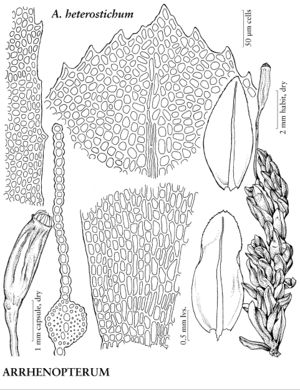Arrhenopterum
Sp. Musc. Frond., 198, plate 46, figs. 1 – 9. 1801.
| Taxon | Illustrator ⠉ | |
|---|---|---|
 | Arrhenopterum heterostichum | Patricia M. Eckel |
Stems with hyalodermis absent. Leaves somewhat complanate, oblong-ovate, some asymmetric, concave; base weakly decurrent, abruptly narrowed and rounded to insertion; margins strongly serrate distally; laminal cell abaxial and adaxial surfaces bulging, smooth or low papillose-mammillose, papillae 1 per cell, weakly developed or absent, walls not collenchymatous. Specialized asexual reproduction by leaflike propagula smaller than more proximal leaves. Sexual condition autoicous; perigonia budlike in series down stem; perichaetial paraphyses of 8–15 cells. Seta single, reddish-brown. Spores 10–15 µm, punctate.
Distribution
North America, Asia
Discussion
Species 1.
The separation of Arrhenopterum and Aulacomnium makes the latter morphologically more homogeneous. Arrhenopterum is distinguished from Aulacomnium by leaf stance (more or less complanate) and asymmetry (laminae on either side of the costa unequally wide), prominent marginal teeth, laminal cells with low mammillose papillae or cells bulging and smooth, and autoicous sexuality. The Southern Hemisphere Australian genus Mesochaete Lindberg is sister to Arrhenopterum in molecular phylogenies. The outer perigonial leaves have slightly flaring apices; the inner leaves are concave basally.
Selected References
None.